National Geographic Expeditions “West Coast of Africa”
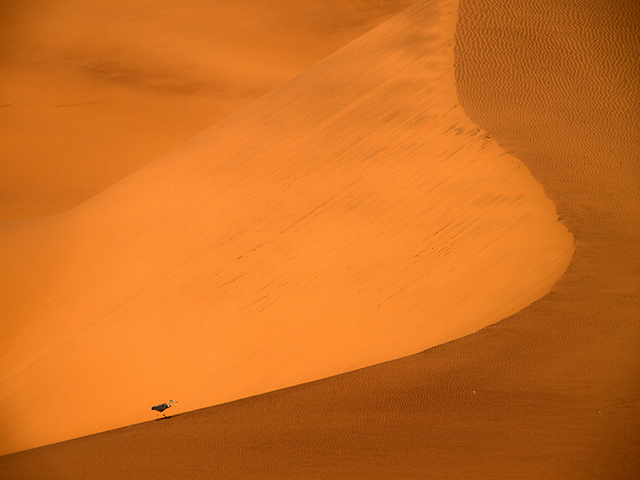
Heron on Namib Sand Dunes
Sailing the West Coast of Africa- sounds like a definition of 19th century exploration. However, I’m sure those people had it a little rougher than we are experiencing this trip aboard the National Geographic Explorer.
16 countries over a 5-week stretch, from Capetown, South Africa to Agadir, Morocco, this adventure will provide an amazing exposure to an area of the world not commonly frequented by western travelers.
Arriving in Capetown after 4 viewings of “TinTin” on our long-haul aircraft, we overnighted in that awesome city. My birthday was on the first day, and Becky arranged with Rikki Swenson for a surprise “event”. Our group was taken to a seaside open-air performance hall for a concert by a South African band, “FreshGround” and after the event
One desire of this trip was to reduce the weight of my camera bag as well as my physical “photographer” presence by using a smaller system. On the recent National Geographic Traveler Seminar series, those attendees have heard me discuss the benefits of traveling with one of the new mirrorless camera systems as it is certainly more conducive to carrying and presents a less intrusive persona. My choice is the Olympus Pen system. Carrying three bodies in my kit and several lenses, my bag still weighs considerably less than my usual camera case. The lenses range from an 18mm equivalent (the 9-18mm) out to a 600mm equivalent (the 75-300mm) Plus, I’m carrying a 24mm f2 and 90mm f1.8 (the 12mm and 45mm respectively) for not only low light demands but to work more unobtrusively.
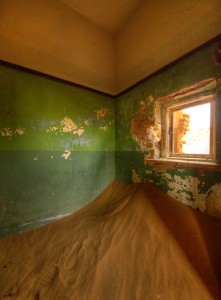
Namibian ghost town of Kolmanskop
We’re early in the trip, having spent time in South Africa and Namibia. I’d shot an assignment in Namibia a few years ago, and our foray into the desert yesterday reinforced how astounding this place is. Looking like a tortured moonscape, the landscape provides a constant photo opp of barren lands and twisted geography.
Below, you’ll find a few tips on the process of making panoramic photos…I’ll be posting more tips and trip overview as this voyage continues…next stop, Angola.
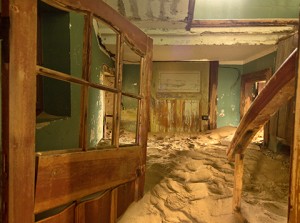
Namibian ghost town of Kolmanskop
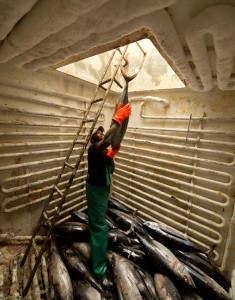
Off-loading tuna in Luderitz, Namibia
A few hints to improve your panoramic photography:
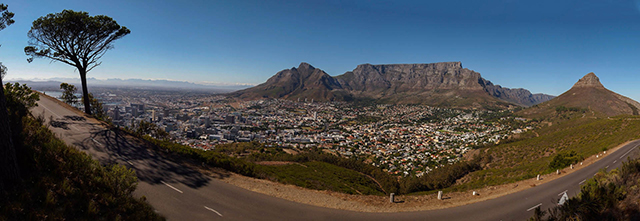
Capetown, South Africa
- Always shoot vertically. This provides extra room for error as well as deepening the photo. Nothing worse than doing your first pano attempt and having the picture tilted up or downhill, requiring a severe horizontal or vertical crop-which will make a really wide and very skinny (top to bottom) photo!
- Use manual mode for both exposure and white balance: this will eliminate the chance of an auto white balance or exposure change over the expanse of the image. If not comfortable with manual mode try this: point your camera at a part of the scene which is towards the brightest range of the area you are going to photograph. Press the shutter down half-way, and note what the exposure readout is in the viewfinder. Note that exposure, change the camera to manual mode and set the camera to that exposure
- Determine a good starting point on the left as well as noting where you’ll snap the final frame on the right (ending) point of the picture. Be sure to “start and finish” the frame with good composition in mind
- Preferably use a tripod for this, as you want to rotate the camera on as center an axis as possible. If you don’t have a tripod, don’t do a big “sweep” of left to right, instead try to move the camera as if mounted in place . This makes it much easier for the software to merge the photos
- Don’t use extreme wide angle, as this also creates a problem in merging the images. A 35mm is a good wide angle for this.
- Start beyond the left end of yoru intended frame and make the last exposure beyond the right end of the picture
- Overlap each frame about 20-30% and use the focus points in the viewfinder as a reference point for the horizon.
- Import the photos into your merge software (Photoshop, Photoshop elements, Aperture, Lightroom as well as almost all manufacturers proporietary software, and watch the magic occur.




